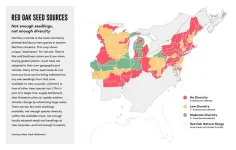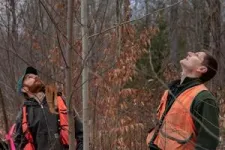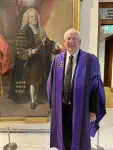(Press-News.org) The REPLANT Act provides money for the US Forest Service to plant more than a billion trees in the next nine years. The World Economic Forum aims to help plant a trillion trees around the world by 2030. Many US cities have plans to shade their streets with millions of trees. Major government and private funding is being invested in planting trees as a powerful tool to fight climate change, protect water, clean air, and cool cities. In short, trees are hot.
But new research shows a troubling bottleneck that could threaten these efforts: U.S. tree nurseries don’t grow close to enough trees—nor have the species diversity needed—to meet ambitious plans.
The study was published in the journal Bioscience on July 31, 2023.
Seedling Scarcity
“Trees are this amazing natural solution to a lot of our challenges, including climate change. We urgently need to plant many millions of them,” says University of Vermont scientist Tony D’Amato who co-led the new research. “But what this paper points out is that we are woefully underserved by any kind of regional or national scale inventory of seedlings to get the job done.”
A team of 13 scientists, led by D’Amato and UVM post-doctoral scientist Peter Clark, studied 605 plant nurseries across twenty northern states. Only 56 of these grow and sell seedlings in the volumes needed for conservation and reforestation and only 14 of them were government-operated, they report. The team was more dismayed to discover an “overwhelming scarcity of seedlings,” they write, from different species and “seed collection zones”—trees adapted to local conditions and climate. In essence, forest nurseries tended to maintain a limited inventory of a select few species, electing to prioritize those valued for commercial timber production over species required for conservation, ecological restoration, or climate adaptation. Moreover, many areas had no locally adapted tree stock available. (See map for example.) And within the seedlings available, there were not enough types of trees and “future-climate-suitable” genetics to meet goals for conservation and forest restoration in a hot future.
“The world is thinking about a warming climate—can we plant towards that warming climate? We know we’re losing ecologically important species across North America and around the world. So, the goal is: can we restore these trees or replace them with similar species? It’s a powerful idea,” says UVM’s Peter Clark, the lead author on the new study. “But—despite the excitement and novelty of that idea in many policy and philanthropy circles—when push comes to shove, it's very challenging on the ground to actually find either the species or the seed sources needed.”
“The number of seedlings is a challenge,” Clark says, “but finding the diversity we need to restore ecologically complex forests—not just a few industrial workhorse species commonly used for commercial timber operations, like white pine—is an even bigger bottleneck.”
One extreme example is red spruce. This ecologically important species along hundreds of miles of eastern North America has been under stress for decades from climate change, pests, and land clearing. Yet, in their 20-state survey, the team only found two tree nurseries that had inventory of red spruce, a species from which many millions of seedlings are needed to meet restoration goals. “Remarkably, only 800 red spruce seedlings were commercially available for purchase in 2022,” the team reports in their new Bioscience study, “—enough to reforest less than one hectare.”
“It really points to just how bare the cupboard is when it comes to the diversity of options,” says Tony D’Amato, director of the Forestry Program in UVM’s Rubenstein School of Environment and Natural Resources, “but also the quantity that's needed to make any meaningful impact.”
Increased Investment
The team argues that dramatic increases in both seedling production and diversity at many regional nurseries will be central to any successful campaign to address climate change with tree planting. However, the novelty and risk involved, “likely generates uncertainty among forest nurseries, hampering investment,” they write. This appears to be especially true in regions, like the Northeast, where nurseries have declined over recent decades, the study reports, and where speculative investment—in growing new, future-climate-adapted, non-timber species and seedlots—may carry high financial risk.
Additionally, seedlings brought in from outside a region may be less likely to succeed. The new study reports that the vast majority (80%) of seedlings in the northern states, where the study was conducted, are produced in the North Central states—and very few in the Northeastern states. “Such concentration of production will hinder tree planting efforts,” they write, “because species and seed sources likely originate from similar geographic or bioclimatic zones.” On top of this challenge, seedlings are sensitive to stress. A misalignment between when seedlings are available—say in a southern nursery months before northern soils are frost free—and when they are needed, may doom their chances.
The team of researchers—including scientists from UVM; the USDA’s Northern Forest Research Stations in Minnesota, Michigan and New Hampshire; Minnesota Department of Natural Resources; Wisconsin Department of Natural Resources; Michigan Department of Natural Resources; University of Minnesota; the USDA’s Northern Institute of Applied Climate Science; and The Nature Conservancy (Albany, NY)—recommend a series of improvements from improved policy and financing to better training and expanded research.
For example, today government agencies, such as the US Forest Service and many US state governments, lack clear policies about the movement of tree species and tree genetics. They often rely on seed zones established in the 1970s based on historical climate conditions, not future ones—even though up-to-date guidelines for moving species under a warming climate are becoming available. Additionally, much forest policy and research has been framed around species important for timber production—rather than efforts to diversify species and climate-adapted seed-sourcing.
The team of scientists suggest that expanded federal and state investment will be needed to boost both public tree nurseries and seed collection efforts. “This strategy may stimulate production from private nurseries once a stable demand is apparent,” they write. In 2023, the federal government made an investment of $35 million in expanding federal nursery capacity. “However, given the existing (and growing) reforestation backlog, declines in nursery infrastructure, and complex needs for diverse seeds and seedlings, it is likely that substantially more public investment in the form of grants, loans, and cost-share programs will be needed to reinvigorate, diversify, and expand forest nurseries,” they write.
“People want trillions of trees,” says the University of Vermont’s Peter Clark, “but often, on the ground, it’s one old farmer walking around to collect acorns. There’s a massive disconnect.”
END
Plans to plant billions of trees threatened by massive undersupply of seedlings
US efforts to fight climate change with tree planting at risk from lack of stock and species diversity, new research shows
2023-07-31
ELSE PRESS RELEASES FROM THIS DATE:
Hollings director honored as fellow of Royal College of Physicians
2023-07-31
Raymond N. DuBois, M.D., Ph.D., director of MUSC Hollings Cancer Center, has been inducted as a fellow into the Royal College of Physicians (RCP).
DuBois traveled to London, England, for the ceremony in July. He had been elected to the prestigious body prior to the COVID pandemic, which delayed the induction ceremony.
The Royal College of Physicians was established in 1518 by a royal charter from King Henry VIII. The college's founding aim was to professionalize physicians through an academic body that required a degree and an exam before ...
NIH launches long COVID clinical trials through RECOVER Initiative, opening enrollment
2023-07-31
EMBARGOED FOR RELEASE
Monday, July 31, 2023
Noon EDT
Contact
NIH Office of Communications and Public Liaison
NIH News Media Branch
301-496-5787
NIH launches long COVID clinical trials through RECOVER Initiative, opening enrollment
Today, the National Institutes of Health launched and is opening enrollment for phase 2 clinical trials that will evaluate at least four potential treatments for long COVID, with additional clinical trials to test at least seven more treatments expected in the coming months. Treatments ...
Johnson-Matthews receives funding for conference: VL/HCC 2023 Graduate Consortium
2023-07-31
Brittany Johnson-Matthews, Assistant Professor, Computer Science, received funding from the National Science Foundation for: "Conference: VL/HCC 2023 Graduate Consortium."
This award will support the Graduate Consortium at this year's IEEE Conference on Visual Languages and Human-Centric Computing (VL/HCC), which will be held in Washington, D.C. October 2-6, 2023.
Johnson-Matthews said, "This funding will support the ability for students across the country to come together, network, share their research, and curate advice on completing their PhD from senior members of the VL/HCC community."
VL/HCC ...
Wang conducting finite temperature simulation of non-Markovian quantum dynamics
2023-07-31
Wang Conducting Finite Temperature Simulation Of Non-Markovian Quantum Dynamics
Fei Wang, Assistant Professor, Chemistry and Biochemistry, received funding from the National Science Foundation for the project: "Finite temperature simulation of non-Markovian quantum dynamics in condensed phase using quantum computers."
For this research, Wang will develop efficient quantum algorithms to perform condensed phase quantum dynamics simulations on quantum computers.
Many important physical and chemical processes occur in the condensed phase, spanning chemical reactions in solutions, charge transfer at semiconductor interfaces, ...
Study demonstrates efficacy of new short-term resistant TB treatment
2023-07-31
(Boston) – Tuberculosis (TB) disproportionately affects vulnerable populations including those with limited economic resources, HIV patients, those whose diet is deficient in nutrients and others. Resistant TB (MDR TB) does not respond to first line medications and is difficult to treat, requiring long regimens of 15-20 months that are associated with significant side effects and poor outcomes.
Recently, new six-month regimens have been shown to have better results than the long-term treatments, with improved quality of life and health equity. But these novel regimens have not yet been adopted widely in the United States. ...
The rise of bio-concrete (video)
2023-07-31
WASHINGTON, July 31, 2023 — Concrete is the most important building material on Earth, but its production causes a MASSIVE amount of global carbon emissions. Join George as he discovers how a surprising discovery in 1973 could dramatically change how we make concrete forever. https://youtu.be/fEt92F1c730
Reactions is a video series produced by the American Chemical Society and PBS Digital Studios. Subscribe to Reactions at http://bit.ly/ACSReactions and follow us on Twitter @ACSReactions.
The American Chemical Society (ACS) is a nonprofit organization chartered by the U.S. Congress. ACS’ ...
GPT-3 can reason about as well as a college student, UCLA psychologists report
2023-07-31
People solve new problems readily without any special training or practice by comparing them to familiar problems and extending the solution to the new problem. That process, known as analogical reasoning, has long been thought to be a uniquely human ability.
But now people might have to make room for a new kid on the block.
Research by UCLA psychologists shows that, astonishingly, the artificial intelligence language model GPT-3 performs about as well as college undergraduates when asked to solve the sort of reasoning problems that typically appear on intelligence tests and standardized tests such as the SAT. The study is published in Nature Human Behaviour.
But the paper’s authors ...
Associations of military-related traumatic brain injury with new-onset mental health conditions and suicide risk
2023-07-31
About The Study: In this study including 860,000 soldiers, rates of new-onset mental health conditions were higher among individuals with a history of military-related traumatic brain injury (TBI) compared with those without. Moreover, risk for suicide was both directly and indirectly associated with history of TBI.
Authors: Lisa A. Brenner, Ph.D., of the VHA Rocky Mountain Mental Illness Research Education and Clinical Center in Aurora, Colorado, is the corresponding author.
To access the embargoed study: Visit our For The Media website at this link ...
Association of racial and ethnic identity with attrition from M.D.-Ph.D. Training programs
2023-07-31
About The Study: This study found significant racial and ethnic disparities in attrition from M.D.-Ph.D. training, where Black students had greater than 50% higher odds of leaving M.D.-Ph.D. training than their peers. Notably, compared with 17% of white students, 29% of Black M.D.-Ph.D. students did not complete their training.
Authors: Mytien Nguyen, M.S., of the Yale School of Medicine in New Haven, Connecticut, is the corresponding author.
To access the embargoed study: Visit our For The Media website at this link https://media.jamanetwork.com/
(doi:10.1001/jamainternmed.2023.2822)
Editor’s ...
Association between gestational age and academic achievement of children born at term
2023-07-31
About The Study: The findings of this study of more than 500,000 children suggest that there is no evidence of a difference in math and reading scores over grades 2 to 11 among children born between 39 and 40 weeks’ gestation, and overall no evidence of better scores among those born at 41 weeks’ gestation compared with 40 weeks’ gestation. The results can further inform decisions on delivery timing at term birth by offering insights into long-term associations of delivery timing with cognitive development and school achievement.
Authors: George L. Wehby, M.P.H., Ph.D., of ...
LAST 30 PRESS RELEASES:
AI overestimates how smart people are, according to HSE economists
HSE researchers create genome-wide map of quadruplexes
Scientists boost cell "powerhouses" to burn more calories
Automatic label checking: The missing step in making reliable medical AI
Low daily alcohol intake linked to 50% heightened mouth cancer risk in India
American Meteorological Society announces Rick Spinrad as 2026 President-Elect
Biomass-based carbon capture spotlighted in newly released global climate webinar recording
Illuminating invisible nano pollutants: advanced bioimaging tracks the full journey of emerging nanoscale contaminants in living systems
How does age affect recovery from spinal cord injury?
Novel AI tool offers prognosis for patients with head and neck cancer
Fathers’ microplastic exposure tied to their children’s metabolic problems
Research validates laboratory model for studying high-grade serous ovarian cancer
SIR 2026 delivers transformative breakthroughs in minimally invasive medicine to improve patient care
Stem Cell Reports most downloaded papers of 2025 highlight the breadth and impact of stem cell research
Oxford-led study estimates NHS spends around 3% of its primary and secondary care budget on the health impacts of heat and cold in England
A researcher’s long quest leads to a smart composite breakthrough
Urban wild bees act as “microbial sensors” of city health.
New study finds where you live affects recovery after a hip fracture
Forecasting the impact of fully automated vehicle adoption on US road traffic injuries
Alcohol-related hospitalizations from 2016 to 2022
Semaglutide and hospitalizations in patients with obesity and established cardiovascular disease
Researchers ‘listen in’ to embryo-mother interactions during implantation using a culture system replicating the womb lining
How changing your diet could help save the world
How to make AI truly scalable and reliable for real-time traffic assignment?
Beyond fragmented markets: A new framework for efficient and stable ride-pooling
Can shape priors make road perception more reliable for autonomous driving?
AI tracks nearly 100 years of aging research, revealing key trends and gaps
Innovative techniques enable Italy’s first imaging of individual trapped atoms
KIER successfully develops Korea-made “calibration thermoelectric module” for measuring thermoelectric device performance
Diversifying US Midwest farming for stability and resilience
[Press-News.org] Plans to plant billions of trees threatened by massive undersupply of seedlingsUS efforts to fight climate change with tree planting at risk from lack of stock and species diversity, new research shows




